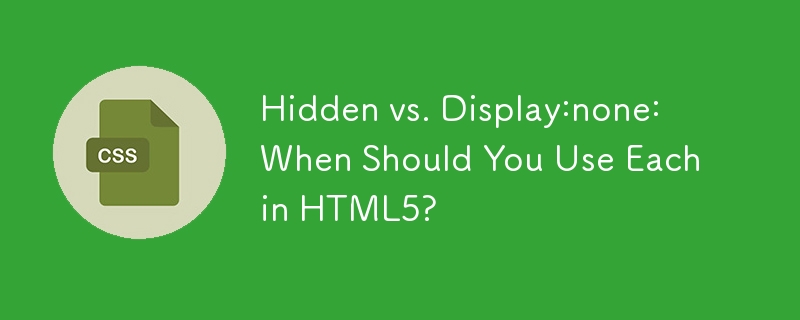Hidden vs. Display:none: When Should You Use Each in HTML5?

Understanding the Differences Between HTML5's Hidden Attribute and CSS's display:none
In the realm of web development, the challenge of concealing content has led to two distinct strategies: HTML5's hidden attribute and CSS's display:none rule. While visually identical, these methods possess crucial semantic and computational differences.
Semantic Distinction
The hidden attribute designates an element as perpetually hidden, regardless of presentation context. This implies that both visual browsers and assistive technologies, such as screen readers, will ignore hidden content. Conversely, display:none can be applied conditionally, enabling elements to be hidden in specific contexts while remaining accessible to assistive technologies.
Computational Impact
Web browsers typically implement the hidden attribute using display:none internally. However, the key distinction lies in the element's state during DOM traversal. Hidden elements are never part of the DOM tree, while display:none elements are present but visually concealed. This difference affects subsequent calculations related to layout, accessibility, and other DOM manipulations.
Usage Guidelines
When choosing between hidden and display:none, consider the following guidelines:
- If content should be hidden in all presentation contexts, including assistive technologies, use the hidden attribute.
- If content should be conditionally hidden based on context or device, use display:none.
- For elements that require visual concealment but should remain accessible to assistive technologies, consider using a combination of display:none and the appropriate aria attribute (e.g., aria-hidden="true").
By understanding the nuances between these two approaches, developers can effectively manage content visibility while ensuring accessibility and UX optimization.
The above is the detailed content of Hidden vs. Display:none: When Should You Use Each in HTML5?. For more information, please follow other related articles on the PHP Chinese website!

Hot AI Tools

Undresser.AI Undress
AI-powered app for creating realistic nude photos

AI Clothes Remover
Online AI tool for removing clothes from photos.

Undress AI Tool
Undress images for free

Clothoff.io
AI clothes remover

Video Face Swap
Swap faces in any video effortlessly with our completely free AI face swap tool!

Hot Article

Hot Tools

Notepad++7.3.1
Easy-to-use and free code editor

SublimeText3 Chinese version
Chinese version, very easy to use

Zend Studio 13.0.1
Powerful PHP integrated development environment

Dreamweaver CS6
Visual web development tools

SublimeText3 Mac version
God-level code editing software (SublimeText3)

Hot Topics
 1666
1666
 14
14
 1425
1425
 52
52
 1325
1325
 25
25
 1273
1273
 29
29
 1252
1252
 24
24
 A Comparison of Static Form Providers
Apr 16, 2025 am 11:20 AM
A Comparison of Static Form Providers
Apr 16, 2025 am 11:20 AM
Let’s attempt to coin a term here: "Static Form Provider." You bring your HTML
 A Proof of Concept for Making Sass Faster
Apr 16, 2025 am 10:38 AM
A Proof of Concept for Making Sass Faster
Apr 16, 2025 am 10:38 AM
At the start of a new project, Sass compilation happens in the blink of an eye. This feels great, especially when it’s paired with Browsersync, which reloads
 Weekly Platform News: HTML Loading Attribute, the Main ARIA Specifications, and Moving from iFrame to Shadow DOM
Apr 17, 2025 am 10:55 AM
Weekly Platform News: HTML Loading Attribute, the Main ARIA Specifications, and Moving from iFrame to Shadow DOM
Apr 17, 2025 am 10:55 AM
In this week's roundup of platform news, Chrome introduces a new attribute for loading, accessibility specifications for web developers, and the BBC moves
 The Deal with the Section Element
Apr 12, 2025 am 11:39 AM
The Deal with the Section Element
Apr 12, 2025 am 11:39 AM
Two articles published the exact same day:
 Some Hands-On with the HTML Dialog Element
Apr 16, 2025 am 11:33 AM
Some Hands-On with the HTML Dialog Element
Apr 16, 2025 am 11:33 AM
This is me looking at the HTML element for the first time. I've been aware of it for a while, but haven't taken it for a spin yet. It has some pretty cool and
 Multi-Thumb Sliders: General Case
Apr 12, 2025 am 10:52 AM
Multi-Thumb Sliders: General Case
Apr 12, 2025 am 10:52 AM
The first part of this two-part series detailed how we can get a two-thumb slider. Now we'll look at a general multi-thumb case, but with a different and
 How We Tagged Google Fonts and Created goofonts.com
Apr 12, 2025 pm 12:02 PM
How We Tagged Google Fonts and Created goofonts.com
Apr 12, 2025 pm 12:02 PM
GooFonts is a side project signed by a developer-wife and a designer-husband, both of them big fans of typography. We’ve been tagging Google
 Where should 'Subscribe to Podcast' link to?
Apr 16, 2025 pm 12:04 PM
Where should 'Subscribe to Podcast' link to?
Apr 16, 2025 pm 12:04 PM
For a while, iTunes was the big dog in podcasting, so if you linked "Subscribe to Podcast" to like:




